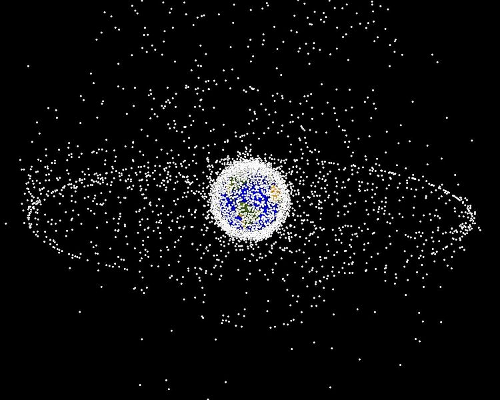A British firm is working on a harpoon to retrieve space debris such as defunct satellites. The idea is to spear the debris and then pull it down towards Earth to be burned up in the atmosphere.
The project is the work of Astrium UK, a global company’s branch in Stevenage (which coincidentally is the town where I spent my teenage years.) It claims itself to be the third biggest company in the world dedicated to space engineering and related activities.
The idea is to tackle the large number of man made objects in orbit that no longer serve any purpose, whether they be out-of-service satellites, used rocket sections, or simply tiny scraps caused by collisions. These now pose a genuine threat of damage to the surface of spacecraft because the speed of orbit means even a tiny object could collide with violent force.
The NASA image above is not a photograph, but rather a computer generated image of orbiting junk that is already being tracked. The dots are to show positioning only and thankfully aren’t in scale to the Earth.
Estimates range from 16,000 to 22,000 larger objects and perhaps half a million pieces that are at least a centimeter across. The thinking behind the project is that removing the larger items is the priority, simply because the larger the items, the greater the chances two could collide and create even more smaller items that are more difficult to deal with.
Ironically the plan involves putting another satellite in space, which would be targeted to within 100 meters of a known piece of space junk. Ground staff would then take a look at video footage and decide whether to move the satellite in to a 20 meter range.
From there, the satellite would shoot out a 30 cm spear on a polymer cord. The spear would pierce the casing of the object. From here, either the satellite itself would drag the object to Earth, or the spear would be released with a thruster unit to drag the object, leaving the satellite free to move on to another target.
Researchers have already tested an experimental version of the harpoon, working on both the accuracy of its aim and the delicate balance of getting enough force to attach to the object, but slowing down quick enough to avoid going right through and piercing fuel tanks. If that happens, you’re looking at an explosion and in turn far more space debris.

